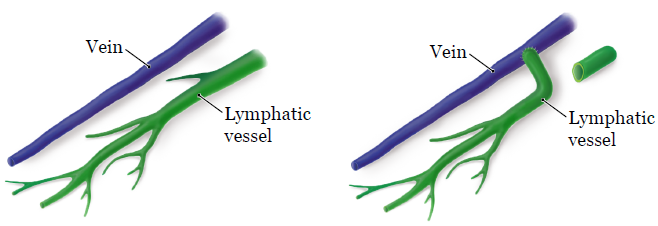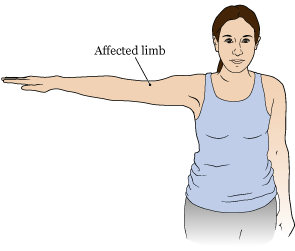This information explains immediate lymphatic reconstruction (ILR). It also will help you know what to expect after your breast surgery with axillary lymph node dissection and ILR.
About Lymphedema
When lymph nodes in your armpit are removed, nearby lymphatic vessels can be damaged. This can make it hard for your lymphatic system to drain like it should. If this happens, lymphatic fluid can build up in your arm, hand, breast, or torso (body) on your affected side. Your affected side is the side of your body where your lymph nodes were removed.
When too much lymphatic fluid builds up in an area, it causes swelling. This swelling is called lymphedema (LIM-fuh-DEE-muh). You may also feel heaviness or pain in the area, have a higher risk for infections, or both. Lymphedema symptoms can be mild or severe (strong) enough to make the area grow very large. Some people don’t have symptoms for months or years after surgery.
Out of every 100 people who have an axillary lymph node dissection:
- About 15 to 25 people get lymphedema.
- About 75 to 85 out of every 100 people don’t get lymphedema.
If you’ve had radiation therapy in the area, your risk of getting lymphedema may be higher.
There’s no cure for lymphedema, but there are treatments, such as massage and compression garments. Compression garments are pieces of clothing that squeeze an area of your body to help with swelling.
For more information, read Common Questions about Breast Cancer-Related Lymphedema.
About ILR
ILR is a procedure to rebuild damaged lymphatic vessels. This can help lymphatic fluid drain from an area. ILR can lower your chance of getting lymphedema.
Your plastic surgeon will do your ILR procedure during your breast surgery. They will do it after your breast surgeon finishes your axillary lymph node dissection. It most often takes less than 1 hour.
You don’t need to follow any extra steps to get ready for your breast surgery.
During your ILR procedure
First, your plastic surgeon will find the damaged lymphatic vessels. To do this, they’ll inject (give you a shot of) green dye. It will go in the space between your fingers and the underside of your wrist on your affected side. The dye travels through your lymphatic vessels so they’re easier to see.
Once your plastic surgeon sees the damaged lymphatic vessels, they’ll join them to a nearby vein (see Figure 1). This lets the lymphatic fluid drain from the area.

After your ILR procedure, your surgeon will finish your breast surgery as usual.
For the first 2 weeks after your ILR procedure
Your breast surgeon will tell you how to care for yourself after your surgery. Follow their instructions and the instructions below.
-
Avoid compressing or putting pressure on the area of your axillary lymph node dissection.
- Choose loose clothing that doesn’t squeeze the area.
- Don’t use lots of gauze or padding in your bra. A member of your care team will show you how much is safe to use.
-
Don’t raise your affected arm more than 90 degrees, which is shoulder height (see Figure 2). You can straighten your elbow, but don’t raise your arm past this height.

Figure 2. Arm raised 90 degrees - Follow your breast surgeon’s instructions for doing range of motion exercises after breast surgery. They’ll give you written instructions. You can also find the instructions online at www.mskcc.org/pe/exercises_mastectomy. Remember not to raise your affected arm more than 90 degrees while you’re doing them.
- If fluid starts to collect in your armpit, call your breast surgeon right away. The fluid may cause swelling in a small, defined area (like a golf ball). Or, it may cause puffiness in a larger area. A member of your care team will tell you what to look out for.
Your urine (pee) and the skin between your fingers and under your wrist might be discolored after your procedure. This is from the dye your plastic surgeon injected. The color will fade over a few days.
Starting 2 weeks after your ILR procedure
Starting 2 weeks after your surgery, you don’t need to limit your range of motion. You can raise your arm above 90 degrees. If your breast surgeon gives you other instructions, follow those instead.